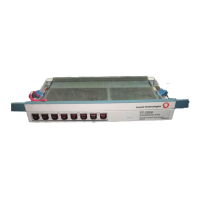Applications
2-2 Issue 8.0 July 2002
To accommodate loop and interoffice routes, the standard performance and high
performance 1.3 µm OC-48 high-speed interfaces support spans of at least 53
and 60 kilometers, respectively. The standard performance 1.5 µmOC-48
high-speed interface supports spans of at least 92 kilometers. In Release 4 and
later releases, the standard performance 1.5 µm OC-48 high-speed interface
supports spans of at least 92 kilometers. In Release 5 and later releases, the
lightwave booster amplifier (LBA) standard performance 1.5 µmOC-48
high-speed interface supports spans up to 140 kilometers (km) using standard
fiber and spans up to 160 km using dispersion-shifted fiber. For more information
about transmission distances, refer to Volume I, Section 10, "Technical
Specifications."
The FT-2000 OC-48 Add/Drop-Rings Terminal typically interfaces to digital
multiplexers, such as the DDM-2000 Multiplexers, to digital access and
cross-connect systems such as DACS III-2000, DACS IV-2000, or Tellabs
TITAN
5500/S, a digital switch, or other facilities.
Network Configurations 2
This section describes many of the network configurations in which the FT-2000
OC-48 ADR Terminals can be used. In addition to the configurations specifically
described, many other combinations of these network configurations can be used
to meet specific application/customer needs.
Two-Fiber Bidirectional Line-Switched Rings 2
The FT-2000 OC-48 Add/Drop-Rings Terminal and FT-2000 OC-48 Dual
Lightwave Terminating Bay may be configured to support two-fiber bidirectional
line-switched rings. Bidirectional line-switched rings provide redundant
bandwidth and/or equipment to ensure system integrity in the event of any
transmission or timing failure, including a fiber cut or node failure.

